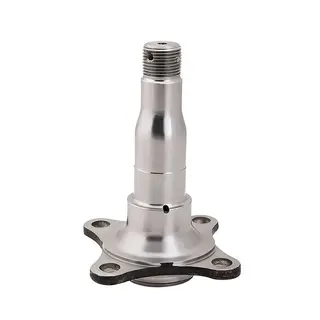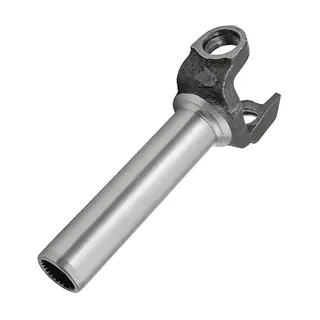In modern manufacturing, hot die forging technology, with its excellent performance and wide application, has become an indispensable process for producing complex metal components. It not only manufactures high-strength and high-precision parts but also significantly improves production efficiency and reduces manufacturing costs. This article will explore in depth the process flow, main advantages, and applications of hot die forging in various key fields, helping readers fully understand this advanced manufacturing technology.
Hot die forging is a process in which heated metal billets are placed into the die cavity, and plastic deformation is achieved through pressure or impact to obtain forgings consistent with the cavity shape. It combines the precision of die forging and the plasticity advantages of hot processing, and is widely used in key fields such as aerospace, automobile industry, and energy equipment. The core principle of hot die forging lies in using high temperatures (usually between 1000°C and 1300°C) to significantly increase the plasticity of metal materials while greatly reducing their deformation resistance. Under this condition, the metal billet, under the huge pressure exerted by a hot forging press in a precision die cavity, flows like a high-viscosity fluid, finally obtaining a forging highly consistent with the shape of the die cavity.
The typical process flow of hot die forging includes billet preparation and heating, pre-forming and preliminary forging, final forging, and post-forging treatment. The following is a detailed description of each step.
Material Selection: Select suitable metal materials according to the mechanical performance requirements of the forging (such as strength and toughness) and the characteristics of the forging process. Common materials include carbon steel, alloy structural steel, stainless steel, etc. For example, automotive gears often use 20CrMnTi alloy carburizing steel.
Cutting: The raw material is cut into billets of specific weight and size using saw machines (band saw, circular saw), shearing machines, or flame cutting equipment. The burn-off allowance during the forging process (generally 1.5%–3% of billet weight) and subsequent machining allowance must be reserved.
Surface Cleaning: Remove oil, rust, and oxide scale from the billet surface using sandblasting, pickling, or grinding to prevent impurities from being pressed into the forging during the process and forming defects.
Purpose of Heating: Heating can improve metal plasticity, reduce deformation resistance, facilitate the billet to fill the die cavity, and at the same time reduce forging energy consumption and mold wear.
Heating Temperature Control: The heating temperature must be strictly controlled within the forging temperature range of the material. For example, the initial forging temperature of carbon steel is 1100–1250°C, and the final forging temperature is 800–850°C. Excessively high temperature will cause overburning (melting of grain boundaries), while too low a temperature will easily cause cracking. The heating rate is determined according to the billet size and material thermal conductivity to avoid excessive internal and external temperature differences that produce thermal stress. Large billets need slow heating, while small parts can be heated quickly.
Holding Time: Ensure uniform temperature inside and outside the billet. The holding time is usually calculated as 0.5–1 hour for every 10 mm of billet diameter (adjusted according to furnace type and material). Common furnaces include box-type resistance furnaces, trolley furnaces, or continuous heating furnaces (more efficient for mass production).
Purpose of Pre-forming: To pre-form simple-shaped billets into intermediate billets close to the final forging shape, enabling reasonable metal distribution, facilitating the subsequent filling of complex die cavities, reducing die wear, and avoiding forging defects.
Common Pre-forming Processes:
Upsetting: Shortening the billet axially and increasing its diameter through pressure, suitable for disc-type forgings (such as gear blanks).
Drawing Out: Reducing the cross-section of the billet and increasing its length, suitable for the shaft part of shaft-type forgings.
Roll Extrusion: Transferring part of the billet metal through molds to adjust the billet's volume distribution, commonly used for forgings with bosses or grooves.
Bending: Bending billets into specific angles, used for non-linear forgings such as crankshafts and hooks.
Pre-forming can be completed on free forging equipment (such as air hammers) or special pre-forming presses.
Final Forging Process: The heated (or reheated after preforming) billet is placed into the cavity of a hot forging die, and pressure is applied by equipment to cause the billet to undergo plastic deformation, fill the cavity, and form the forging shape.
Equipment Selection:
Die Forging Hammer: Forms parts through impact, suitable for small and medium-sized forgings with high productivity.
Hot Forging Press: Forms through static pressure, with stable deformation and high forging precision, suitable for mass production (such as automobile connecting rods and half-shafts).
Flat Forging Machine: Suitable for forgings with holes or steps (such as bolt heads and tee fittings).
Trimming: Remove excess flash from the forging to ensure that the external dimensions meet requirements.
Straightening or Finishing: Correct or finish the forgings to ensure their shape and dimensional accuracy. Through these steps, high-quality forgings are finally obtained.
Hot die forging technology has many remarkable advantages, making it occupy an important position in modern manufacturing. The main advantages are as follows.
Hot die forging, through intense plastic deformation at high temperatures, effectively breaks coarse cast grains, welds internal pores, and forms fine, uniform recrystallized structures. This process significantly improves the strength, toughness, and fatigue life of materials, ensuring high performance of forgings.
Hot die forging can produce parts with complex inner cavities or external shapes. Utilizing the "fluid-like" characteristics of metal at high temperatures, the metal smoothly fills complex mold cavities, forming continuous and dense internal metal flow lines. This gives hot die forging a unique advantage in manufacturing complex structures, while cold forging or machining often fails to achieve such results.
Hot die forging can achieve "near-net shaping," where the forging's shape and dimensions are close to the final product, reducing subsequent machining allowances. This not only saves material but also improves production efficiency and reduces manufacturing costs. By using near-net forming production technology, hot die forging reduces the amount of excess material to be machined away, making it an economical and efficient choice for mass production.
Hot die forging is applicable to various forgeable materials, including ferrous and non-ferrous metals, as well as alloys and special materials. It ensures compatibility with various materials, allowing manufacturers to produce components suitable for specific applications and industry requirements. For example, in the aerospace field, hard-to-deform materials can only achieve effective plastic forming within specific high-temperature ranges through hot die forging, while optimizing internal structure.
Hot die forging has significant advantages in production efficiency. Compared with other forging methods, this process requires a shorter production cycle, thereby improving productivity. In addition, the molds used in hot die forging have longer service life and durability, reducing downtime for maintenance and tool replacement. These factors together improve productivity and cost-effectiveness.
The controlled heating and forming process of hot die forging minimizes surface defects such as cracks and irregularities. Therefore, forged parts usually require minimal or no post-forging treatment, reducing additional machining steps and costs. The improved surface finish not only enhances the appearance of the parts but also improves their functional performance and reliability.
Hot die forging demonstrates irreplaceable strategic value in key fields such as aerospace, automobile industry, and energy equipment. The following are its specific applications in these fields.
In the aerospace field, extremely high requirements are placed on the strength, toughness, and reliability of materials. Hot die forging can handle complex geometries, conquer high-strength and hard-to-deform materials, and achieve optimized internal structures and maximum performance. For example, key components such as turbine blades and disks of aircraft engines are manufactured through hot die forging, ensuring high performance and reliability under extreme conditions.
In the automobile industry, many load-bearing, safety, and transmission parts are formed by hot die forging. For example, connecting rods, crankshafts, and half-shafts of automobiles are produced through hot die forging, which not only improves their mechanical properties but also achieves lightweight and high precision. The application of hot die forging in the automotive industry improves production efficiency and reduces manufacturing costs, providing strong support for high performance and reliability.
In the energy equipment field, parts such as turbine blades and bearing rings manufactured by hot die forging ensure high performance and reliability under extreme conditions such as high temperature and pressure. The application of hot die forging technology in the energy equipment field not only improves equipment operation efficiency but also extends service life, providing important support for the sustainable development of the energy industry.
Although hot die forging has many significant advantages, it also faces some challenges. The main challenges and their countermeasures are as follows.
Hot die forging dies need to withstand high temperature and high pressure, so they must be made of high-quality heat-resistant materials, leading to high mold costs. To address this challenge, manufacturers can reduce die costs by optimizing die design, adopting advanced manufacturing technologies (such as 3D printing), and extending die service life.
Hot die forging requires extremely strict control of process parameters, including heating temperature, holding time, and forging pressure. Any deviation may lead to a decline in forging quality. To address this challenge, manufacturers can ensure precise control of process parameters through advanced automatic control systems, real-time monitoring equipment, and strict quality inspection procedures.
Hot die forging technology is an efficient and advanced manufacturing process widely used in key fields such as aerospace, automobile industry, and energy equipment. Through high temperature and high pressure, it plastically shapes metals into desired forms, featuring significant advantages such as eliminating internal defects, manufacturing complex-shaped parts, achieving near-net shaping, improving production efficiency, excellent surface finish, and material diversity. Although it faces challenges such as high mold cost and strict process control, through optimized mold design, intelligent manufacturing technology, and green manufacturing concepts, hot die forging technology will continue to progress and innovate, providing strong support for the development of modern manufacturing.



